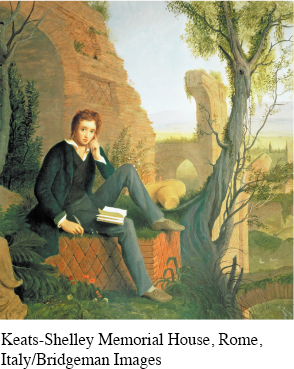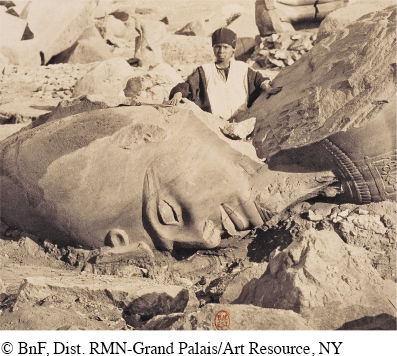Ozymandias
Percy Bysshe Shelley

Percy Bysshe Shelley (1792–
KEY CONTEXT In this poem, the speaker relates the account of a traveler who is walking through a vast desert when he encounters the ruins of Ozymandias, almost entirely buried in the sand. Ozymandias, more commonly known as Ramses II, was an Egyptian pharaoh of the Nineteenth Dynasty.
333


Consider this photograph of the actual archaeological dig that unearthed the statue of Ramses II referred to in this poem.
I met a traveller from an antique land
Who said: “Two vast and trunkless legs of stone
Stand in the desert. Near them, on the sand,
Half sunk, a shattered visage lies, whose frown,
5 And wrinkled lip, and sneer of cold command,
Tell that its sculptor well those passions read
Which yet survive, stamped on these lifeless things,
The hand that mocked them and the heart that fed.
And on the pedestal these words appear —
10 ‘My name is Ozymandias, king of kings:
Look on my works, ye Mighty, and despair!’
Nothing beside remains. Round the decay
Of that colossal wreck, boundless and bare
The lone and level sands stretch far away.”
Understanding and Interpreting
Based on the description of Ozymandias’s expression, as well as the inscription on the pedestal, what kind of ruler was Ozymandias?
The inscription on the pedestal exhorts those who read it to look on Ozymandias’s works and “despair” (l. 11). However, all that remains of the “works” are a decaying “colossal wreck” (l. 13) in the desert. In what ways is this an ironic commentary on the nature of human power?
Analyzing Language, Style, and Structure
The first line of the poem begins with the word “I,” but then introduces a “traveller from an antique land” who then completes the remaining lines. What is the effect of this narrative structure, and how does it help convey the meaning of the poem?
The traveler describes the “frown, / And wrinkled lip, and sneer of cold command” (ll. 4–
5) that the sculptor “mocked” (l. 8). “Mocked” can mean “described” as well as the more modern definition of “imitated in an unflattering manner.” How do these two definitions of the same word create different ways of interpreting the sculptor’s original goal?
334
Connecting, Arguing, and Extending
Unchecked pride, or hubris, is the subject of many works of literature. Choose something you have read in the past, or a movie you have seen, in which hubris plays a significant role. Discuss the role of hubris in your selected example, specifically explaining how it influenced the story.
If Ozymandias were able to see his own statue wearing down to nothing in the desert, do you think he would elect to change the inscription, or would he retain the original wording? Explain.